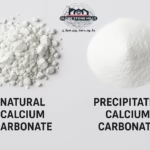Calcium Carbonate and Iron, steel
Iron and steel are among the most important materials that contributed to building human civilization. Since ancient times, humans have used them to manufacture tools, weapons, and construction. Calcium carbonate, also known as limestone, played an important role in this journey, helping to improve the quality of iron and steel and lowering the cost of production.
Historically:
The use of iron dates back to the Iron Age, around 1200 BC, when it was extracted from its ores and smelted in primitive furnaces. Iron remained the main material for making tools and weapons until the nineteenth century when a method was discovered to produce steel, a mixture of iron and carbon.
Calcium carbonate in the iron and steel industry:
Calcium carbonate is used in the iron and steel industry for multiple purposes, the most important of which are:
- Removing impurities: Calcium carbonate helps remove impurities in iron ore, such as silica and alumina, which affect the quality of iron and steel.
- Reducing the melting point of iron ore: Calcium carbonate helps lower the melting point of iron ore, facilitating the smelting process and reducing energy consumption.
- Improving the quality of iron and steel: Calcium carbonate helps improve the properties of iron and steel, such as strength, hardness, and corrosion resistance.
- Reducing the cost of production: Calcium carbonate helps reduce the cost of producing iron and steel, due to its ease of obtaining and low price.
Limestone: an ally of the iron and steel industry
Limestone, chemically known as calcium carbonate, is an important element in the iron and steel industry. This sedimentary rock is used in two forms: pure limestone and dolomite, which contains magnesium carbonate in addition to calcium carbonate.
How is limestone used in the iron and steel industry?
Limestone smelting:
- Limestone is heated in a kiln to convert it into calcium oxide (CaO).
- Calcium oxide reacts with impurities in the iron ore to form less dense compounds that float to the surface of the melt.
Mixing calcium oxide with iron ore:
- This process causes a number of reactions, the most important of which are:
- Reducing the melting temperature of iron from 1538 to 1300 degrees Celsius.
- Removal of impurities, such as silica oxide and aluminum oxide.
- The formation of slag, a liquid substance that floats on the surface of the melt and helps remove remaining impurities.
Benefits of using limestone in the iron and steel industry:
Improve iron quality:
- Removing impurities from pig iron produces high-quality impurity-free iron.
Reduce production cost:
- Reducing the melting temperature of iron reduces energy consumption in the smelting process.
- Slag formation helps remove remaining impurities.
Examples of uses of limestone in the iron and steel industry:
Production of high-quality steel:
- Limestone is used in the production of stainless steel and heat-resistant steel.
Wood iron production:
- Wood iron is used in the manufacture of cars and electrical appliances.
- Limestone helps remove impurities from iron ore used in the production of wooden iron.
Cast steel production:
- Cast steel is used to make pipes and tanks.
- Limestone helps form slag in the cast steel smelting process.
Recent Posts
- Globe Stone Hills: Your Comprehensive Guide to High-Quality Calcium Carbonate Solutions
- The Role of Calcium Carbonate in Soap and Detergent Manufacturing
- Precipitated vs Ground Calcium Carbonate: Key Differences, Uses & Benefits
- Calcium Carbonate Quarries in Egypt | High-Purity White Mineral for Industries
- Difference Between Coated and Uncoated Calcium Carbonate
Latest Posts
Contact the Globe Stone Hills team
Gallery
- © Copyright 2024. Globe Stone Hills




















